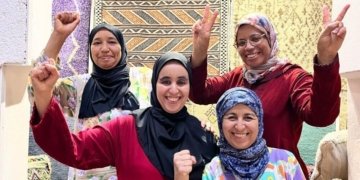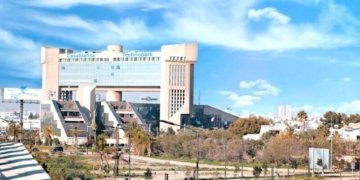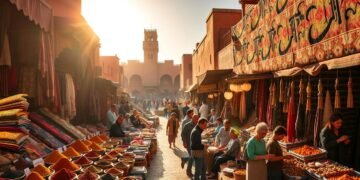What if one country could transport you through centuries of vibrant traditions in just a single visit? Morocco offers exactly that—a living museum where ancient customs thrive in modern life. With 37.7 million people preserving their heritage, this North African gem stands as a cultural crossroads.
From UNESCO-listed cities like Fes and Chefchaouen to intricate zellij tilework, every corner tells a story. The blend of Berber, Arab, and French influences creates a unique tapestry seen in leather crafts, tea rituals, and hypnotic Gnawa music.
Architectural wonders, from ancient kasbahs to restored riads, showcase the country’s artistic mastery. Morocco’s synthesis of tradition and innovation makes it a global leader in preserving heritage while embracing the present.
Key Takeaways
- Morocco blends Berber, Arab, and French influences into a vibrant cultural identity.
- UNESCO recognizes its heritage sites, including Fes and Chefchaouen.
- Traditional crafts like zellij tilework and leatherwork thrive in bustling souks.
- Gnawa music combines rhythmic beats with spiritual chants.
- Architectural marvels range from historic kasbahs to modern riad restorations.
Introduction to Morocco’s Vibrant Cultural Heritage
Few places weave together diverse traditions as seamlessly as Morocco. Its cultural DNA stems from a rare trifecta: Arab, Berber, and Andalusian roots. This blend shapes everything from architecture to daily rituals.
The Blend of Influences Shaping Moroccan Identity
Over 20 million Berbers preserve three distinct languages, adding layers to the nation’s voice. Jewish craftsmanship, like artifacts in London’s museums, survives despite the 1948 exodus. The result? A living heritage where past and present coexist.
Geography plays a starring role. The Atlas Mountains and Sahara create isolated microclimates, sheltering unique customs. Four Berber groups—Rifains, Chleuhs, and others—add regional flavors to the mix.
Why Moroccan Culture Stands Out in North Africa
With 11 fixed public holidays, Morocco honors its history while neighbors rely on movable Islamic dates. Its 4.7% population growth outpaces the region, fueling cultural evolution.
From synagogues in Marrakech to nomad traditions in the desert, this country defies simple labels. Its ability to adapt while preserving ancient ways makes it a beacon in north africa.
Historical Roots of Moroccan Culture
Long before modern borders existed, Morocco’s cultural identity was taking shape through centuries of layered influences. Three distinct eras—indigenous Berber, Arab-Islamic, and European colonial—left their mark on the nation’s architecture, crafts, and social elements.
Berber Influence: The Oldest Indigenous Traditions
Bocchus I established the first Berber kingdom in 110 BCE, creating a foundation for indigenous traditions that survive today. The MNAC Barcelona’s 1896 painting documents Berber bride rituals still practiced in remote villages.
Four main Berber groups preserved unique languages and customs. Their revolt in 740 CE against Arab rule shows their enduring cultural pride.
Arab and Islamic Contributions to Moroccan Art
The 7th-century Arab conquest brought new forms of artistic expression. Geometric patterns flourished after the University of Al Quaraouiyine’s 859 AD founding.
Moulay Ismail organized craft guilds in the 1600s, standardizing techniques. This system created the intricate tilework seen in mosques today.
Andalusian and Colonial Legacies
Spanish refugees introduced Hispano-Roman fusion techniques in zellij tilework. The French Protectorate (1912-1956) later added Art Deco influence to cities like Casablanca.
Volubilis’ Roman ruins show how ancient designs still impact modern architecture. This blend of eras makes Morocco’s history uniquely visible in daily life.
Moroccan Art and Culture Highlights: A Visual Journey
Step into a world where every tile and thread tells a story of centuries-old craftsmanship. From the mathematical precision of zellij mosaics to the symbolic knots in Berber carpets, these creations are more than decor—they’re cultural narratives.
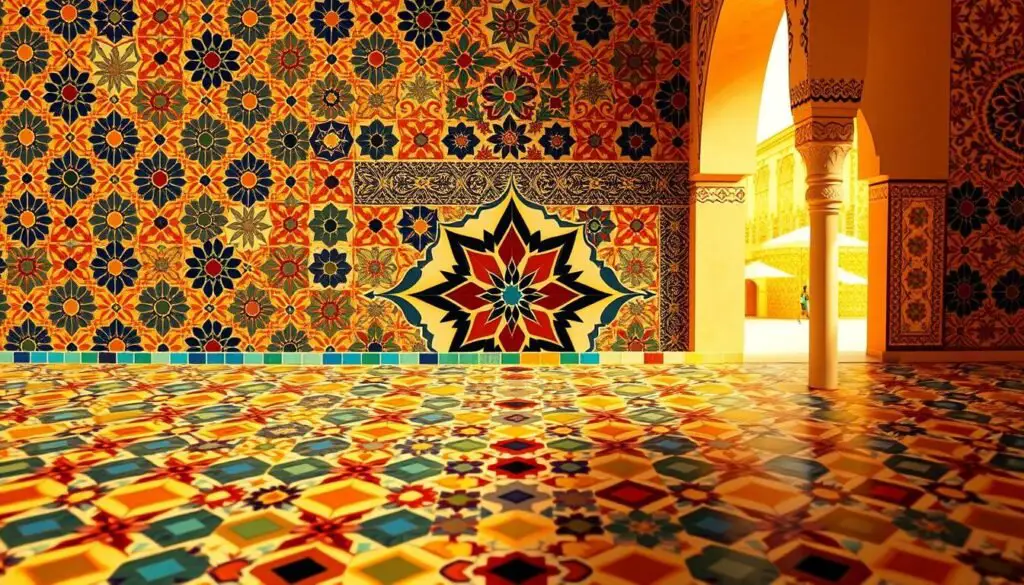
Intricate Zellij Tilework and Geometric Designs
Zellij tilework is a celebrated art form, dating back to the 14th century. Craftsmen in Fez hand-cut glazed tiles into star patterns with flawless symmetry. The British Museum preserves fragments showcasing this legacy.
Modern adaptations shine in Casablanca’s Hassan II Mosque. Here, traditional designs meet contemporary scales, proving their timeless appeal. Each piece reflects Morocco’s fusion of math and creativity.
The Timeless Beauty of Moroccan Carpets
Rabat’s undyed wool carpets are global treasures. Woven by Berber women, these textiles encode tribal stories through symbols. A diamond might represent protection; zigzags trace life’s journey.
Atlas Mountain herds provide the wool, cleaned and spun by hand. Unlike synthetic rugs, these pieces age gracefully, often becoming family heirlooms. Their earthy tones bring warmth to any home.
Fez and Safi ceramics offer another contrast. The city of Fez favors cobalt blues, while Safi’s polychrome pots burst with color. Both styles rely on local clay and generations of expertise.
The Craftsmanship Behind Moroccan Handicrafts
The hands of artisans transform raw materials into timeless treasures. Across cities like Fez and Safi, age-old techniques thrive, blending precision with cultural pride. Each craft—from leather to silver—carries a legacy of innovation.
Fez’s Legendary Leather Tanneries
Chouara Tannery’s stone vats, dating to the 11th century, host a 36-step process. Artisans use pigeon droppings to soften hides, a tradition unchanged for generations. The result? Vibrant babouche slippers, though podiatrists note their flat soles lack arch support.
Handmade Ceramics: From Fez to Safi
Fez’s cobalt-blue faience contrasts with Safi’s rainbow-hued pottery. Over 200 workshops in Safi rely on underground clay pits, kneading local soil into durable art. Each piece reflects regional identity, fired in kilns perfected over centuries.
Silver and Jewelry: Berber and Arab Inspirations
Berber fibulae feature geometric boldness, while Arab filigree twists metal into lace-like jewelry. Tiznit’s artisans master silver niello inlay, etching blackened designs onto polished surfaces. Essaouira’s thuya wood carvers spend seven years apprenticing to perfect floral motifs.
Anti-counterfeiting seals now protect Argan wood products, ensuring craftsmanship stays authentic. Whether in a tannery’s pungent pits or a silversmith’s quiet studio, Morocco’s artisans keep history alive.
Moroccan Tea Culture and Culinary Traditions
A single sip of mint tea reveals centuries of hospitality woven into daily life. This nation’s food rituals blend flavor with symbolism, from saffron’s golden hue to couscous’ communal roots. Each dish tells a story of trade routes and timeless traditions.
The Art of Serving Mint Tea
The “three-pour” ceremony is a dance of precision. Green tea, fresh mint, and sugar simmer in a silver pot. The first pour aerates the brew, the second balances sweetness, and the third honors the guest.
Locals consume 4.2kg of sugar yearly through tea—proof of its cultural grip. Served in ornate glasses, it’s a gesture of warmth in homes and markets alike.
Tagine, Couscous, and Other Iconic Dishes
Fassi tagine leans sweet with prunes, while Marrakshi versions favor preserved lemons. Both slow-cook in conical clay pots, tenderizing meats and melding spices.
Couscous grains vary from mhamsa (pearl-sized) to berkoukes (chunky). UNESCO-recognized Taliouine saffron, with 3.84% crocin, fights depression and heart disease.
Bissara soup’s 2:1 fava bean ratio fuels chilly mornings. Each bite connects diners to generations of culinary craftsmanship.
Music and Festivals: The Rhythms of Morocco
The pulse of Morocco beats strongest in its music and festivals, where ancient rhythms meet modern creativity. These events aren’t just performances—they’re bridges between generations. Visitors find themselves swept into celebrations that have shaped identities for centuries.
Gnawa Music and Its Spiritual Roots
All-night lila ceremonies stretch 6-8 hours, blending prayer with hypnotic beats. Originally created by Bambara slaves, song codes reference West African spiritual journeys. The metallic clang of qraqeb castanets drives trance-like dances.
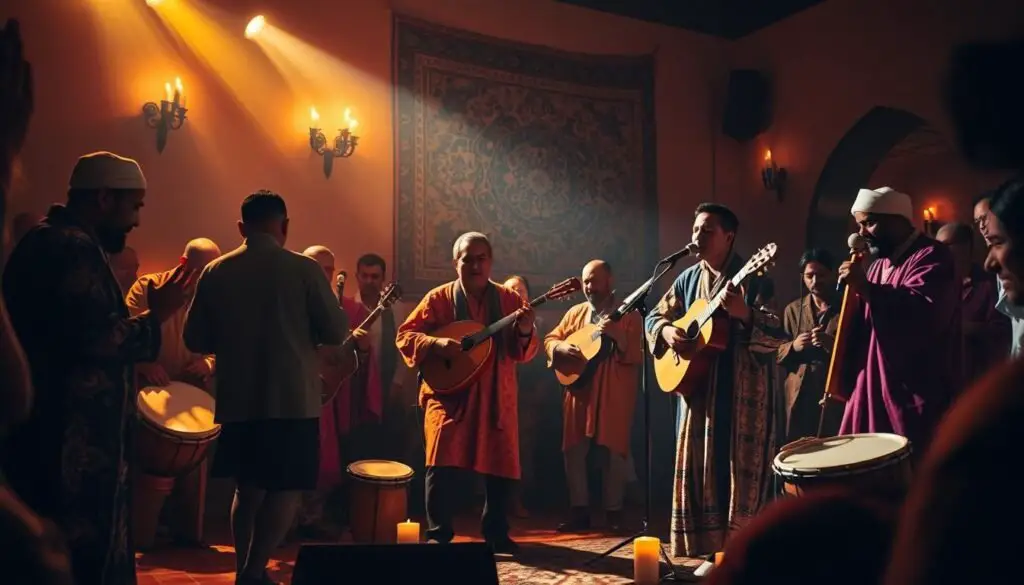
Mehdi Nassouli reimagines these traditions, fusing Gnawa with jazz and blues. His work preserves the music’s healing purpose while attracting new audiences. Oud strings, made from 37-day fermented sheep gut, produce its signature resonant tones.
Marrakech International Film Festival
This star-studded event generated $8.3M in 2022, boosting local businesses. Unlike European festivals, it prioritizes African and Arab cinema. Screenings in historic palaces create unforgettable experiences.
The Fes Festival of World Sacred Music draws 200,000 visitors yearly. Meanwhile, Chaabi pop music updates classical Malhun poetry with electric instruments. Each event showcases Morocco’s ability to honor roots while embracing innovation.
From Sufi chants to red carpet premieres, these celebrations prove artists are the nation’s cultural torchbearers. They transform cities into living stages where every performance writes history anew.
Architecture: From Kasbahs to Modern Riads
Hollywood directors choose Moroccan structures when they need authenticity that stands the test of time. The Aït Benhaddou kasbah alone appeared in 23 films, from Gladiator to Game of Thrones. This legacy spans two architectural eras—ancient desert strongholds and reinvented urban dwellings.
Berber Kasbahs and Their Desert Legacy
Stacked thermal mass walls in kasbahs create natural air conditioning. The Glaoui family’s 19th-century forts near the Atlas Mountains used 3-foot-thick earth bricks to stay cool. Defensive features like zigzag entrances confused invaders.
Modern engineers 3D-scanned 14th-century Fes arches to decode their stability. The Noor Ouarzazate solar plant adopted these passive cooling styles. Its mirrors follow the sun like kasbah windows track shadows.
The Revival of Traditional Moroccan Design
Riad Zitoune’s 2021 UNESCO award proves old architecture gains new life. Craftsmen repaired its cedar lattices using 11th-century joinery techniques. Philippe Starck’s Mamounia Hotel redesign blends Berber motifs with minimalist furniture.
The Hassan II Mosque’s retractable roof showcases engineering brilliance. Its 210-ton dome opens in 5 minutes, matching ancient ventilation smarts. This place honors heritage while pushing boundaries.
From solar farms to five-star riads, Morocco’s built environment keeps one foot in history. The other strides confidently toward the future.
Morocco’s Living Traditions Today
Digital tools and ancient crafts collide in today’s vibrant creative scene. Young innovators use blockchain and AI to protect traditional moroccan techniques while reaching global markets. The result? A cultural renaissance where heritage meets hyperconnectivity.
Three-quarters of craft businesses now operate online through platforms like Artisanat.ma. This digital shift helps sustain rural economies while preserving handcrafted excellence. From TikTok tutorials to NFT art markets, technology amplifies timeless skills.
How Younger Generations Preserve Heritage
The #MoroccanCrafts hashtag boasts 189 million views as Gen Z documents pottery throwing and rug weaving. Beni Rugs employs AI to generate new patterns rooted in ancestral designs. Bank Al-Maghrib’s $12 million conservation fund supports these hybrid approaches.
Creative Bridges Between Eras
Artists like Sara Ouhaddou reimagine zellij as glass installations, while Yto Barrada embeds fossils in woven textiles. Mohammed Melehi’s abstract wave paintings command $220,000 at auction, proving modern influence on traditional moroccan motifs.
The ABURY Foundation trains 1,300 women in blockchain tracking for handicrafts. These artists and programs ensure cultural continuity across landscapes old and new. Their work makes heritage relevant for today’s global audience.
Conclusion
Three millennia of heritage pulse through every corner of this land. Its cultural highlights bridge eras, from Tiznit’s silversmiths to digital explorations of ancient medinas.
Travel responsibly to support these living traditions. Seek immersive experiences beyond major cities—Safi’s pottery workshops or the Atlas Mountains’ weaving cooperatives.
On the global stage, modern adaptations like VR tours preserve history while engaging new audiences. This nation’s diverse landscapes remain a testament to creativity that honors the past yet innovates for tomorrow.
FAQ
What makes Moroccan craftsmanship unique?
The country’s artisans blend Berber, Arab, and Andalusian techniques to create intricate textiles, ceramics, and jewelry. Each piece reflects centuries of tradition.
How does mint tea play a role in daily life?
Serving mint tea is a symbol of hospitality. The ritual involves pouring it from a height to create foam, a practice rooted in local customs.
What are the key influences on architecture?
Designs draw from Islamic geometry, Berber fortresses, and French colonial styles. Riads and kasbahs showcase this fusion.
Which festivals celebrate music and film?
The Gnawa World Music Festival and Marrakech International Film Festival highlight both traditional sounds and modern creativity.
Why is tagine considered a national dish?
Slow-cooked in clay pots, tagine combines spices, meats, and fruits. It represents the country’s rich culinary heritage.
How do younger generations engage with traditions?
Many collaborate with elders to revive crafts, while others reinterpret them through contemporary art and fashion.







